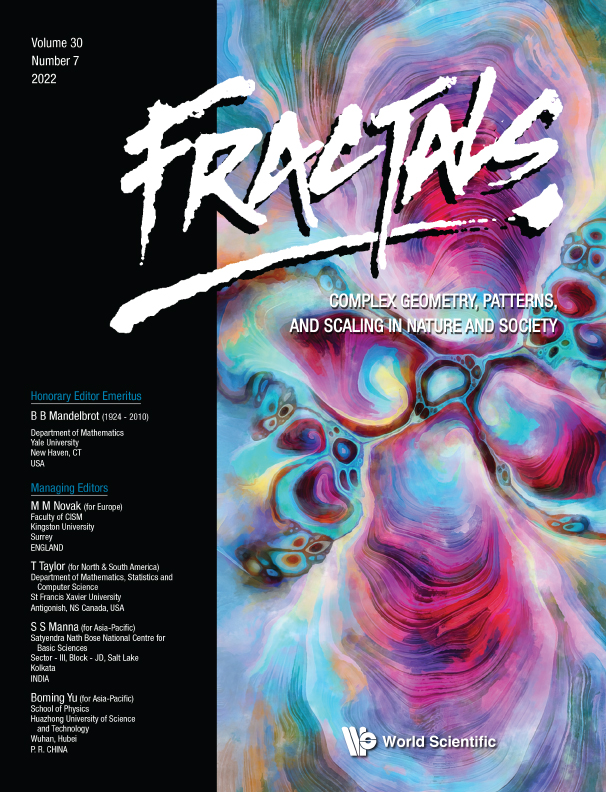AFFINE FRACTAL LEAST SQUARES REGRESSION MODEL
Abstract
This paper develops a method to find fractal curves to fit real data. With a formulation for fractal functions through a type of affine systems of iterative functional equations, we apply the procedure of minimizing the sum of square residuals that is used in the classical linear regression. We develop formulas for approximation and exact fractal functions for various fractal levels and number of equations. This method gives estimates for the parameters of the equations and corresponding functions, namely the fractal coefficients (vertical scaling factors) and directional coefficients. As a consequence, it is possible to upper estimate the Hausdorff dimension of the fitted curve. We provide worked examples, including estimating a fractal curve for a time series real data set of exchange rates between USD and EUR currencies.
References
- 1. , Fractal functions and interpolation, Constr. Approx. 2 (1986) 303–329. Crossref, Web of Science, Google Scholar
- 2. , The calculus of fractal interpolation functions, J. Approx. Theory 57(1) (1989) 14–34. Crossref, Web of Science, Google Scholar
- 3. , Constructive solutions for systems of iterative functional equations, Constr. Approx. 45 (2017) 273–299. Crossref, Web of Science, Google Scholar
- 4. , V-variable fractals: Fractals with partial self similarity, Adv. Math. 218(6) (2008) 2051–2088. Crossref, Web of Science, Google Scholar
- 5. , Fractional fractals, Fract. Calc. Appl. Anal. 23(5) (2020) 1329–1348. Crossref, Web of Science, Google Scholar
- 6. , Fractal calculus on [0,1], Chaos Solitons Fractals 5(6) (1995) 987–1000. Crossref, Web of Science, Google Scholar
- 7. , A review on application of the local fractal calculus, Numer. Comput. Methods Sci. Eng. 1(2) (2019) 57–66. Google Scholar
- 8. , The fractal Dirichlet Laplacian, Rev. Mat. Complut. 24(1) (2011) 189–209. Crossref, Web of Science, Google Scholar
- 9. , Fractal topology foundations, Topology Appl. 159(14) (2012) 3156–3170. Crossref, Google Scholar
- 10. , Optimization on fractals and stability, J. Nonlinear Convex Anal. 13(4) (2012) 695–708. Web of Science, Google Scholar
- 11. , Genetic estimation of iterated function systems for accurate fractal modeling in pattern recognition tools, in Computational Science and Its Applications — ICCSA 2017,
Lecture Notes in Computer Science , Vol. 10404, eds. O. Gervasi (Springer, Cham, 2017), pp. 357–371. Crossref, Google Scholar - 12. , Chaotic optimization and the construction of fractals: Solution of an inverse problem, Complex Syst. 3 (1989) 37–62. Google Scholar
- 13. , Fractal modeling of time-series data, in Twenty-Third Asilomar Conference on Signals, Systems and Computers,
Pacific Grove, CA, USA , 1989, pp. 182–186. Crossref, Google Scholar - 14. , Energy minimizing associate fractal functions, RACSAM 113 (2019) 1025–1039. Crossref, Web of Science, Google Scholar
- 15. , Fractal parameters and well-logs investigation using automated well-to-well correlation, Comput. Geosci. 103 (2017) 59–69. Crossref, Web of Science, Google Scholar
- 16. , Using iterated function systems to model discrete sequences, IEEE Trans. Signal Process. 40(7) (1992) 1724–1734. Crossref, Web of Science, Google Scholar
- 17. , Newton’s method for fractal approximation, Constr. Approx. 5 (1989) 151–170. Crossref, Web of Science, Google Scholar
- 18. , Fractal approximation, Complex Anal. Oper. Theory 4 (2010) 953–974. Crossref, Web of Science, Google Scholar
- 19. , Fractal polynomial interpolation, Z. Anal. Anwendungen 24(2) (2005) 401–418. Crossref, Web of Science, Google Scholar
- 20. , Fractal trigonometric approximation, Electron. Trans. Numer. Anal. 20 (2005) 64–74. Web of Science, Google Scholar
- 21. , Functional equations and nowhere differentiable functions, Aequationes Math. 46 (1993) 243–256. Google Scholar
- 22. , Explicitly defined fractal interpolation functions with variable parameters, Chaos Solitons Fractals 75 (2015) 76–83. Crossref, Web of Science, Google Scholar
- 23. , Fractal and Hausdorff dimensions for systems of iterative functional equations, J. Math. Anal. Appl. 480 (2019) 123429. Crossref, Web of Science, Google Scholar
- 24. , Fitting a least squares piecewise linear continuous curve in two dimensions, Comput. Math. Appl. 41(7–8) (2001) 1033–1041. Crossref, Web of Science, Google Scholar
- 25. , Invitation to Discrete Mathematics (Oxford University Press, 1998). Crossref, Google Scholar
- 26. , Quasi-critical fluctuations: A novel state of matter?, J. Nanoparticle Res. 15(5) (2013) 1407. Crossref, Web of Science, Google Scholar
- 27. , Convex Optimization, 1st edn (Cambridge University Press, 2004). Crossref, Google Scholar
- 28. , Fractal geometry of financial time series, Fractals 3(3) (1995) 609–616. Link, Web of Science, Google Scholar
- 29. , A fractal forecasting model for financial time series, J. Forecast. 23 (2004) 587–602. Crossref, Web of Science, Google Scholar
- 30. , Fractal analysis of forward exchange rates, Acta Polytech. Hungar. 7(4) (2010) 57–69. Web of Science, Google Scholar
- 31. , Evidence of multifractality from CEE exchange rates against Euro, Physica A 419 (2015) 395–407. Crossref, Web of Science, Google Scholar
- 32. , Mixed multifractal analysis of crude oil, gold and exchange rate series, Fractals 24(4) (2016) 1650046. Link, Web of Science, Google Scholar
- 33. , Fractal nature of advanced Ni-based superalloys solidified on board the international space station, Remote Sens. 13(9) (2021) 1–22. Crossref, Web of Science, Google Scholar
- 34. ,
Fractalization of chaos and complexity: Proposition of a new method in the study of complex systems , in Chaos, Complexity and Leadership 2020: Application of Nonlinear Dynamics from Interdisciplinary Perspective,Springer Proceedings in Complexity (Springer, Cham, 2021), pp. 87–105. Crossref, Google Scholar - 35. , A note on fractal interpolation vs fractal regression, Acad. Lett. (2021) 808, https://doi.org/10.20935/AL808. Google Scholar
- 36. , Nouvelles Méthodes Pour La Détermination Des Orbites Des Comètes (F. Didot, Paris, 1805). Google Scholar
| Remember to check out the Most Cited Articles! |
|---|
|
Check out New & Notable Titles in Nonlinear Science |


